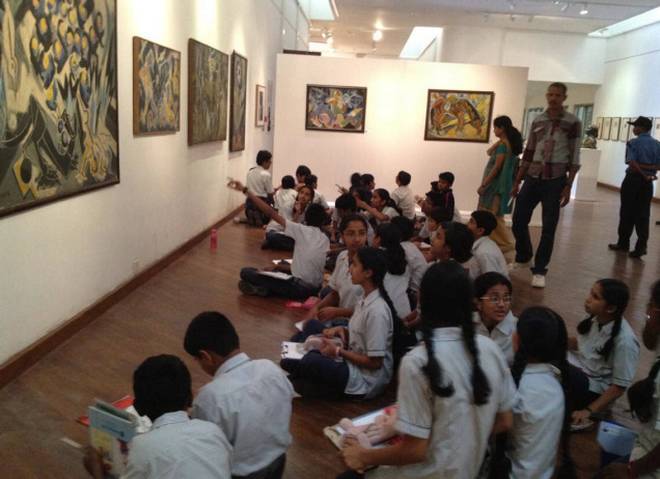What keeps us away from museums? Rereeti, a Bengaluru-based organisation is working on making museums more interactive. They should be places for informal learning and where parents would like children to spend time
http://www.thehindu.com/features/metroplus/making-museums-fun/article7015534.ece
When you think museums in India, what do you think of? For many it’s a place best avoided, a waste of time, with broken sculptures and pieces of pots lying in dusty glass cases. A place you breeze through mandatorily and mindlessly on a city tour when you’re travelling.
Trying to change this mindset — in us, and in the people who create and run museums — is Rereeti. A Bengaluru-based NPO started by Tejshvi Jain, Rereeti aims “to transform Indian museums into spaces of learning, delight and meaningful engagement for visitors”. “There is this common notion of museums being a boring, dull space with dusty exhibits. Very often when you enter a museum, you are totally clueless. Most don’t have websites when the world over, online museums are gaining popularity. There’s no material to tell you what’s in store once you set foot into a museum. There are no labels or texts. Even if they are there, they are archaic. Museums need to make connections with today’s world,” says Tejshvi, founder-director of Rereeti. Reeti in Sanskrit means traditions, and museums are holders of traditions. It is their hope to revitalise these spaces, hence the name Re-Reeti, she explains. She set up the venture with her savings. Armed with a masters in fine arts from the Karnataka Chitrakala Parishath, Tejshvi, who was fond of art history, soon found herself teaching and writing. But when the National Gallery of Modern Art was being set up in Bengaluru, she came on board, and was assistant curator for over four years at the NGMA. In 2012, she was one among 15 participants to be selected by the Bonita Trust and the Ministry of Culture, India to attend a two-week training programme at London’s The Victoria & Albert Museum, which is ranked the world’s largest museum of decorative arts and design. She says her experience there transformed her view of museums. In 2013 she was the only Asian selected to attend the International Visitors Programme by the NRW KULTUR Secretariat, Germany. She was awarded the 2013-14 Art Think South Asia Fellowship.
“I felt the need for a forum like Rereeti for museum professionals. While setting up NGMA, and when we had had no one to turn to for advice and support. In the arts, it is always difficult to find precedents which you can replicate, especially in the museum sector; there are hardly and surveys or data to fall back on,” says Tejshvi. Which is why she worked hard for two years before Rereeti finally took shape as a platform for museum professionals. For the next five years, Rereeti wants to focus on creating informal learning opportunities in museum spaces for schools and families and as a platform for museum professionals for knowledge sharing.
As one of its earliest projects, Rereeti was part of a collaborative effort with the British Council that mapped museums in India; Rereeti coordinated the south India mapping.
“Museums are great spaces for informal learning, especially for children. Nowadays when parents are wondering where to take the kids out, we tend to take them to the malls. We want to change that and make museums attractive. Parents want to take kids to museums but since there is no aid from the museum to connect, they hesitate. We aid this process.”
Rereeti recently launched a pilot project at the Visvesvaraya Industrial and Technological Museum on “Cell Theory” for students of class five, six, and seven. Games, treasure hunts, presentations, and more are combined to get students excited about the subject. In April, they are hoping to do a special summer module involving parents and children across three museums in Bengaluru. “Our modules involve audio, video and kinaesthetic components and we also integrate the seven intelligences into our experience.” Rereeti is developing modules in history, science, and the arts available for school students from the next academic year, in conjunction with museums.
“A lot of museums think ‘setting up’ a museum is the end of it. But we need to work on how to attract visitors. People don’t visit a museum because it doesn’t fulfil their needs. Even among the people working in the museums in India, there is no sense of pride in what they do; you share what you’re proud of. They don’t know the value of what they are preserving. They work for their salaries,” rues Jain. Rereeti organises professional development and capacity building workshops in the area of audience development for museum professionals from all over India.
Their blog and newsletter too discuss crucial topics — How can museums do more with less objects? Why don’t people visit museums more often? Exhibiting culture: what constitutes a good museum exhibit design? Using theatre and performance to engage museum visitors, Belonging to a museum membership organisation etc.
The also have a project online (on Twitter) called “Object of My Affection” where people are asked to view their household objects in a new light, and photograph a thing that they feel is most valuable and worthy of being curated in a museum, and upload them. “We want to instigate people to think about preservation, and what they want to save for the next generation to see.”
To know more about their work, check >https://rereeti.wordpress.com








Recent Comments